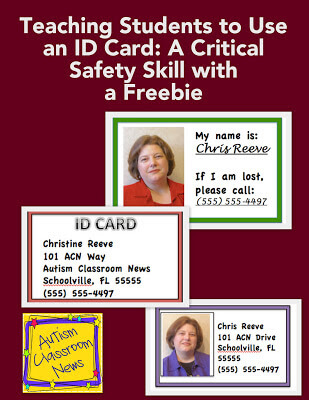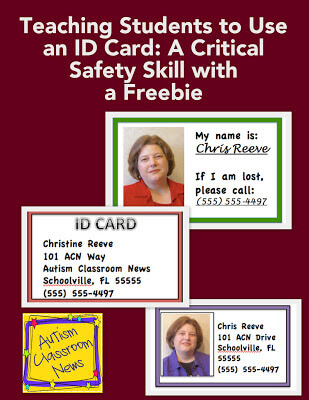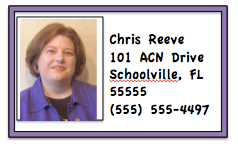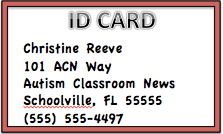Wow, what a busy time of year. Sorry I’ve been absent from my regular posting, but I will try to make it up to you with a freebie in this post. I am back with lots of ideas saved up for blog posts as well as teaching materials to share in the next few weeks.
First, thank you to everyone who made purchases and left feedback on purchases on TPT during the Cyber Sale–or any other time! Your support means the world to me!
Today, I want to talk about an important safety skill that we MUST teach our students early, especially those who are nonverbal. Let me start with a story. When I was an intern, one of my first assignments was to go to the state fair with a group of adults with autism. Some were high functioning, some not so high functioning. Some were verbal and some were not. I was grouped with 2 adults who couldn’t have been more different. I think the only thing they had in common was that they both had autism and they both attended the same adult social skills group for individuals on the spectrum. I also didn’t know them as this was in my first week or two of working with the group. One of the adults I was with, I’ll call him Jim, could make change and had definite ideas about where he wanted to go and what he wanted to do. The other, I’ll call him Tom, could not make change and took more time to process decisions about what he wanted to do. Jim was verbal but minimally so–meaning primarily that he didn’t talk much and when he did he only talked to people he knew (and he didn’t necessarily consider me one of those people yet). He also tended to echo more than provide functional information in communication. Tom was nonverbal. Everything was going well until we got to the ferris wheel. Jim wanted to ride on the ferris wheel. Tom didn’t have enough tickets to ride it and wasn’t sure he wanted to. So Jim got on the ferris wheel and I worked with Tom to understand that he couldn’t and decide if he wanted to buy more tickets. This task was made harder by the fact that he did not bring his communication system with him to the fair. While I was talking with Tom and trying to calm him down because he was getting upset not knowing what he wanted to do, Jim got off the ferris wheel and joined us. He got tired of waiting and before I knew it, I looked up and Jim was gone. Needless to say my stomach bottomed out and I looked around frantically. Now, I’m not a very tall person–some people would even say that at 5 feet, I’m pretty short. So looking over the heads of all the people in the fair was not an easy task. Jim wasn’t terribly tall either so I couldn’t see him anywhere. So I took Tom’s hand and we went looking for Jim. The adults had been told if they got separated from their group they should go to a booth and tell someone they were lost, but they didn’t all know how to do this. I found Jim pretty quickly (although it felt like forever)….standing in the middle of the fairway (or whatever you call the walkway in a fair) raising his hand in the air. Just standing there. The most amazing thing is that all the people just walked around him. Needless to say this is not an effective strategy to use if you are lost. However, it is what Jim had been taught to do if he needed help when he was in school…..raise your hand and wait to be called on. Talk about a skill that doesn’t necessarily translate to other environments.
Now, consider that this is NOT an unusual story (although the raising his hand might be). There has been a great deal of attention in the last year or two about children with autism wandering. We’ve lost way too many children to wandering. It’s not surprising that they are wandering….it is surprising (to me at least) that society is just becoming aware of it. Individuals on the spectrum (even our “high” functioning kids) often have no sense of danger and always seem to be independent in the things we wish they weren’t (i.e., they need 15 prompts to wash their hands but try to ride the bus on their own with no supervision). Their difficulties with social skills compound the problem. These students don’t necessarily know that they need to check in with their parents or their teachers before going somewhere. Then, if they wander and get lost, they frequently don’t have the social problem solving skills to know to go to an adult, identify themselves and give them information to get in touch with their family. So, as teachers, even of our young kids, we need to think about how we can support these students to learn safety skills. Especially at these times of year when families are likely to be traveling, taking children shopping for the holidays, and may be more involved with the community. These are the times when children are more likely to wander.
So what can we do?
1. Teach students to stay with an adult
Well, clearly we can teach our higher functioning students to stay with their parents or teachers when they are out and about. We also need to practice it–talking about it is not enough for our students.
2. Help families develop safety plans
3. Teach students to identify safe adults
We teach a lot of stranger danger to our students. So much so that sometimes typical kids who get lost don’t talk to a stranger to tell him or her how to find their parents. Don’t get me wrong….this is important. However, for kids on the spectrum, they will follow these rules often more strictly. So teach them who might be a good person to talk to as well–a store clerk or someone in a police uniform.
4. Teach students identifying information
Teach your students their first and last name, their address and phone number. Teach it in such a way that they know how to provide that information to unfamiliar people who may ask in unfamiliar ways. Think about how silly it sounds when YOU, the child’s teacher, asks him “What’s your name?” Um, you mean you don’t know? I always think when I do this. It’s the first step, but answering this question in the classroom to familiar people isn’t going to cut it when he finds himself lost at the mall and a policeman asks. So practice giving this information around the building to different people who the child/student is not as familiar with. Have people ask the question in different ways including saying things like, “Little boy, are you lost?” Not every adult they encounter is going to know to ask the question the “right way” (e.g., “what’s your last name?”) to get the needed information.
For nonverbal students or for students who don’t readily use their verbal skills in uncertain situations, when they panic or are scared, or simply don’t use them functionally across environments, consider teaching them to use an ID card. A nonverbal student can present an ID card when someone asks “What is your name?” that has his or her identifying information and be reunited that much faster with their family or group. Just like with the identifying information, we need to teach it across lots of people, in a variety of settings, and with a variety of questions. When asked, “Are you lost?” or “Do you need help?” or just when looking around and realizing their mom or teacher is no longer right beside them. Practice these skills and sabotage situations where your child/student/adult can be safe (you can see them and supervise) but they can’t readily see you and realize they are not where they are supposed to be. Have a person you know (but the student may not) come up to them and ask them if they need help.
To help with this, I’ve included a freebie download in this post to create your own ID card. I’ve included several. They are all pretty basic because I didn’t want anything detracting from its purpose. I’ve made them editable in PowerPoint. If you can’t edit them for some reason and want one you can write on, let me know and I’ll create them. There are three types:
This one is just a picture, name, address and phone number and prints out small enough to be kept in a wallet. There is one this size and one larger than wallet size for students who might need more to hang on to. (No, my pictures are not on them….lucky for you! I just completed these so you could see what they would look like completed.
This one has more basic information in case you or their family don’t want to share address information.
And finally there is a small one that just has information with no picture. There is another one that just has the name and phone number with no picture.
Click here to download the PowerPoint file.
Keep in mind that this is a skill that isn’t just for older students, but is important for all ages. I remember in elementary school, my mother was chaperoning a trip to Disney and we lost one of my best friends–who had no disability. It’s a funny story we tease my mother about because my friend knew to go to a restaurant and tell them she was lost when she realized the person she was following was not actually from our group, so we found her as soon as we found a restaurant after realizing she was lost. If my friend didn’t know to do this, had panicked and not been thinking clearly, or had not had the verbal skills to tell someone who she needed to find, the ending might not have been as happy.
Finally, I know there are safety issues involved with giving strangers identifying information and you will need to discuss the costs and benefits with the families of your students. In my mind, the danger of one of our students wandering and not being able to identify him or herself is much worse than the saner of a stranger having his parents phone number. However, this is a discussion you should have with your students’ families.
There are other options for ID cards as well such as the one offered by the Asperger’s Association of New England for providing to first responders. If your student hasn’t learned this skill yet, my Autism is All About Families board has some ideas like these….
I hope this has raised some thoughts about how we can teach students to be safer in their communities. How do you teach safety skills to your students? Please share in the comments!
Until next time,
And don’t forget to check out more freebies at Freebie Friday!















![Summer resources to help survive the end of the year in special education [picture-interactive books with summer themes]](https://autismclassroomresources.com/wp-content/uploads/2018/05/SUMMER-RESOURCES-ROUNDUP-FEATURE-8528-768x768.jpg)
